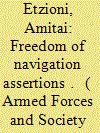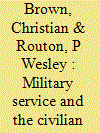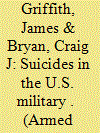|
|
|
Sort Order |
|
|
|
Items / Page
|
|
|
|
|
|
|
| Srl | Item |
| 1 |
ID:
146885


|
|
|
|
|
| Summary/Abstract |
This study examines partnerships between the military and local communities by exploring communication channels of the U.S. military and civilian agencies that provide services to transitioning military members. This article reports on a study conducted in 2013 in the Hampton Roads, Virginia area, designed to determine the degree to which the military enters into partnerships with civilian service providers. We find that navy agencies in Hampton Roads do work with community partners, but the military is more directive than one might imagine in a true partnership, leading to “uneasy” partnerships. Additionally, there are important structural and organizational barriers that prevent true partnerships from developing between navy agencies and the community providers.
|
|
|
|
|
|
|
|
|
|
|
|
|
|
|
|
| 2 |
ID:
146883


|
|
|
|
|
| Summary/Abstract |
Drawing upon data from the Deployment Life Study, this article examines whether female military spouses (SPs) are disadvantaged relative to matched civilian peers in terms of hours worked and earnings, paying particular attention to gaps among the highest educated women. Female SPs do earn less than comparable civilian peers in terms of raw dollars and percentage earnings. Moreover, military wives who are part of the labor force work as many hours as their civilian counterparts, but still earn significantly less for that work. Contrary to predictions, the most educated SPs are not disproportionately affected compared to spouses with less education. These results suggest that SPs at all education levels could benefit from employment assistance; in particular, women already participating in the labor force may benefit from support in finding higher paying jobs.
|
|
|
|
|
|
|
|
|
|
|
|
|
|
|
|
| 3 |
ID:
146881


|
|
|
|
|
| Summary/Abstract |
In line with its “Freedom of Navigation” program, the United States conducts “operational assertions” by sending naval vessels to violate what it considers to be the excessive maritime claims of other states. Efforts have been made to legitimate this program to the public and elected officials on both liberal and realist grounds: Freedom of navigation is an important component of the liberal international order while also central to the exercise of U.S. naval power. However, it does not follow that military assertions, which create a security risk and are inconsistent with liberal principles, should take precedence over diplomatic and multilateral steps. Rather, the program has faced little scrutiny to date due to its relative obscurity.
|
|
|
|
|
|
|
|
|
|
|
|
|
|
|
|
| 4 |
ID:
146882


|
|
|
|
|
| Summary/Abstract |
Although military and civilian personnel work closely together in defense organizations, they are subject to different human resources practices and conditions of service. Assessments of military personnel along a range of job characteristics are examined to identify areas in which they assess themselves as “better or worse off” than their civilian counterparts, and how these comparisons relate to perceptions of fairness using data from Belgium, Canada, and the Netherlands. Military personnel reported meaningfulness/support aspects (e.g., meaningful work) as similar for military and civilian personnel, indicated that negative impacts (e.g., risk of injury) were greater for military, and perceived variability in instrumental benefits (e.g., pay, advancement). Upward social comparison (i.e., seeing oneself as worse off) was related to lower perceived fairness, whereas downward social comparison was related to higher perceived fairness. This research informs mechanisms for promoting perceptions of fairness and enhancing military–civilian personnel relations in defense establishments.
|
|
|
|
|
|
|
|
|
|
|
|
|
|
|
|
| 5 |
ID:
146886


|
|
|
|
|
| Summary/Abstract |
An estimated 70,000 personnel are annually released at the prime of life from the Indian armed forces to maintain a youthful service profile. The migration of veterans in search of a second career to civil society involves managing crucial socioeconomic needs. This article examines the resettlement needs of veterans using survey research which measured resettlement needs of air force veterans in two distinct districts (regions) in India (N = 400). The analysis reveals that the educational needs of dependent children are on top of the agenda followed by the need to find civilian employment. This study also develops a socioeconomic need continuum and a motivation model of resettlement.
|
|
|
|
|
|
|
|
|
|
|
|
|
|
|
|
| 6 |
ID:
146884


|
|
|
|
|
| Summary/Abstract |
The average American military enlistee is likely to differ from the average civilian in employment ambitions and prospects. Current research on veteran wages, however, only examines the effect of military service on average earnings. We employ quantile regression techniques to estimate the effect of military service for the above- and below-average earnings that veterans may experience. We draw data from two longitudinal surveys, one including veterans who served during 1980–1994 and the other including veterans of the early 21st-century wars in Afghanistan and Iraq. For the 21st-century cohort, we find that military service appears to increase wages at and below the median wage but decrease earnings at the high end of the distribution, although these benefits may take several years after service and entry into the civilian labor market to appear.
|
|
|
|
|
|
|
|
|
|
|
|
|
|
|
|
| 7 |
ID:
146880


|
|
|
|
|
| Summary/Abstract |
This paper builds a case for examining suicide in the U.S. military relative to broad societal context, specifically, the unique experiences of birth cohorts relating to processes described by Durkheim’s theory of suicide. In more recent birth cohorts, suicide rates have increased among teenagers and young adults. In addition, suicide rates of age intervals at a given time period have been reliably predicted by the size of the birth cohort and the percentage of nonmarital births—supposed indicators of Durkheim’s diminished social integration and behavioral regulation. Consequences of these trends are likely more evident in the U.S. military due to having proportionally more individuals known to be at risk for suicide, that is, young males who are from nontraditional households. The all-volunteer force compared to draft force has fewer applicants to select, and proportionally more of applicants are accepted for military service. Consequently, more recruits having varied conditions now than before, perhaps including greater vulnerability to suicide, serve in the U.S. military. These points are further elaborated with supporting evidence, concluding with a call for new directions in suicide research, practice, and policy.
|
|
|
|
|
|
|
|
|
|
|
|
|
|
|
|
|
|
|
|
|